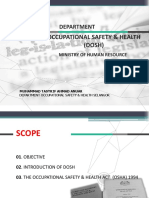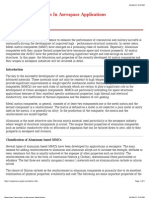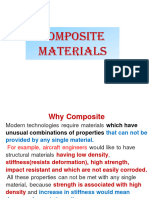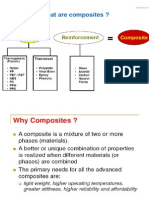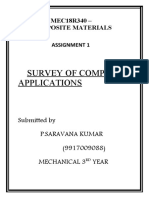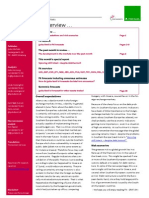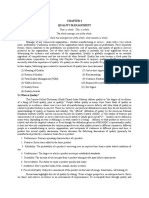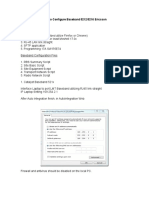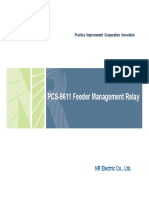Ceramic Matrix Composites in Ceramic Applications Raether 042013 PDF
Ceramic Matrix Composites in Ceramic Applications Raether 042013 PDF
Uploaded by
Shaiful Ridzuan MokhtarCopyright:
Available Formats
Ceramic Matrix Composites in Ceramic Applications Raether 042013 PDF
Ceramic Matrix Composites in Ceramic Applications Raether 042013 PDF
Uploaded by
Shaiful Ridzuan MokhtarOriginal Title
Copyright
Available Formats
Share this document
Did you find this document useful?
Is this content inappropriate?
Copyright:
Available Formats
Ceramic Matrix Composites in Ceramic Applications Raether 042013 PDF
Ceramic Matrix Composites in Ceramic Applications Raether 042013 PDF
Uploaded by
Shaiful Ridzuan MokhtarCopyright:
Available Formats
TECHNOLOGY INSIGHTS
MATERIALS
Ceramic Matrix Composites
an Alternative for
Challenging Construction Tasks
Ceramic Matrix Composites (CMC) are extremely valuable for
applications with demanding thermal and mechanical requirements.
CMC have been developed to achieve a damage tolerant quasi-ductile
fracture behavior and to maintain all other advantages of monolithic
ceramics at high temperatures.
eramic matrix composites (CMC) are
produced from ceramic fibers embedded in a ceramic matrix. Various ceramic
materials, oxide or non-oxide, are used for
the fibers and the matrix. Also a large
variety of fiber structures is available. So
properties of CMC can be adapted to special construction tasks. They are especially valuable for components with demanding thermal and mechanical requirements.
Motivation
When new components are developed,
usually Finite Element simulations are
used to check the loads during operation
and to optimize geometry. Databases are
available, which allow a quick selection of
the optimum material considering material
properties, cost and process requirements
[1]. If complex requirements are to be fulfilled, different material properties, which
contribute to the same requirement can be
combined to form a material index. Different requirements can lead to conflicting
objectives, which are handled by constructing trade-off surfaces in material
index charts [2].
As an example, a lightweight and stiff plate
is considered which shall be used at tem-
Keywords
Ceramic matrix composites (CMC),
ceramic slurry infiltration,
chemical vapor infiltration,
alumina fibers, silicon carbide fibers
CERAMICAPPLICATIONS 1 (2013) [1]
index I in kg m-3GPa-1/3
fracture energy in kPa-1m-1
Fig. 1
Light-weight materials with maximum stiffness and maximum fracture energy selected from [1].
CMC dominate in a broad range of intermediate fracture energies and indices I, whereas stainless
steel and Ni based alloys dominate at high fracture energies and carbon foam is superior for
extremely small indices I
peratures above 600 C. Brittle fracture of
the plate is not allowed. Such plates can be
used as material support in heat treatment
processes. The first requirement leads to a
minimization of specific weight and a
maximization of flexural modulus E. The
respective material index which combines
both properties is the ratio I = /E1/3. The
best material for the first requirement is
the material with the smallest index I. To
fulfill the second requirement, i.e. to avoid
brittle fracture, the fracture energy shall be
maximized. Fig. 1 shows a selection of
those materials among a database of
4000 materials which have promising
Friedrich Raether
Fraunhofer Center for High Temperature Materials and Design HTL
95448 Bayreuth
Germany
www.htl.fraunhofer.de
Corresponding author:
friedrich.raether@isc.fraunhofer.de
45
TECHNOLOGY INSIGHTS
MATERIALS
peratures in the range of 1000 C to
2000 C. They have an excellent creep
resistance and show high stiffness. The
main disadvantage of monolithic ceramics
is their low fracture toughness, which
leads to brittle fracture and detrimental
thermal shock resistance. CMC have been
developed to achieve a damage tolerant
quasi-ductile fracture behavior and to
maintain all other advantages of monolithic ceramics.
Fig. 2
Fracture surface of a CMC with fiber pull-out
Fig. 3
Stress-strain diagram during fracture of an
Ox/Ox CMC indicated is the respective curve
for monolithic ceramics
properties in terms of these two requirements. The trade-off surface is shown as
well. If the focus is on high fracture energy
customary metals like stainless steel can
be selected, but if greater weight is attached to the first requirement, CMC materials like SiC/SiC and Ox/Ox are superior.
With customary materials, i.e. polymers,
metals and monolithic ceramics typical
limitations occur in operational behavior.
Polymers are rather weak and there use is
limited to low temperatures. Apart from
the refractory metals, which are expensive
and brittle, metals can be used up to
1000 C some special alloys up to
1200 C. A disadvantage of these metals
is their low creep resistance and their
susceptibility to oxidation. Monolithic
ceramics can be used up to very high tem-
46
CMC types and properties
There are many different types of CMC.
Classification is usually done in terms of
fiber and matrix materials separated by a
slash. E.g., C/SiC is a CMC made of carbon
fibers and a silicon carbide matrix. Nonoxide fibers used in CMC are mainly made
of carbon or silicon carbide, oxide fibers of
alumina, mullite or silica. Non-oxide matrices are mostly silicon carbide, carbon or
mixtures of silicon carbide and silicon.
Oxide matrices consist of alumina, zirconia, mullite or other alumino-silicates.
Usually oxide fibers are combined with
oxide matrices and non-oxide fibers with
non-oxide matrices. Thus, the main CMC
types are C/C, C/SiC, SiC/SiC and Ox/Ox,
where Ox represents one of the oxide materials mentioned previously [3]. In addition to matrix and fibers, most CMC contain pores usually between 1 and 30 %.
CMC are further classified according to
their fiber structure, which has a large impact on material properties. Ceramic fibers
have a tensile strength between 1000 MPa
and 7000 MPa about an order of magnitude higher than the strength of the matrix.
Likewise, the elastic modulus of the fibers,
typically between 200 GPa and 900 GPa
is higher than the elastic modulus of the
matrix. The fiber type has to be carefully
selected. Fiber degradation occurs between 1000 C and 2100 C depending on
fiber material and fiber quality. It controls
the maximum service temperature of the
CMC. Continuous or short fibers are used
for CMC manufacture. Fibers can be oriented unidirectional or planar to achieve
special anisotropic properties. Woven or
unwoven fabrics can be used, whereby
textile techniques like breading allow for
3D structures with complex load characteristics.
The interaction between fibers and matrix
during fracture provides the high fracture
toughness of CMC. This interaction is
carefully designed using two complementary concepts [4, 5]:
Weak interface concept: the fibers are
coated to reduce adhesion to the matrix.
During fracture fibers are pulled out of
the matrix and absorb fracture energy
(Fig. 2).
Weak matrix concept: the stiffness of the
matrix is adjusted much lower than the
stiffness of the fibers. During fracture
cracks arise in the matrix and are deflected at the fibers, thereby increasing the
fracture surface and elongation at break
(Fig. 3).
Tab. 1 shows material properties of typical
CMC. Due to anisotropy and different CMC
qualities a broad range is covered [1, 4].
Note that the properties cannot be arbitrarily combined within the given range.
The composition and microstructure of
CMC components has to be carefully designed according to the respective use.
Compared to metals, the most important
advantages of CMCs are a significantly
smaller density, which is important for
lightweight constructions, and a much
higher maximum operating temperature.
For many applications also its resistance
to wear and aggressive chemicals is important. Costs of CMC strongly depend on
composition and manufacturing route.
They vary between some hundred and
some thousand EUR/kg. So, CMC are
expensive compared to other materials
and the high price has to pay off by longer
service life or by a unique performance in
value-added products.
If non-oxide CMC components are used in
oxidic atmospheres at high temperatures,
the components can be protected from
oxidation using environmental barrier
coatings (EBC). Compared to carbon,
silicon carbide is less sensitive to oxidation because it forms a protective layer
of silicon dioxide. In addition to the EBC,
non-oxide fibers used in CMC are often
protected by a fiber coating to avoid attack
of oxygen molecules diffusing through the
pore channels of the matrix.
Applications
CMC are used in many high temperature
processes. They have a very high thermal
shock and creep resistance, which enables
designs with large mechanical and thermal
loads. As an example, Fig. 4 shows some
CERAMICAPPLICATIONS 1 (2013) [1]
TECHNOLOGY INSIGHTS
MATERIALS
Tab. 1
Material properties of typical CMC at ambient temperature, the range reflects minimum and maximum of the respective property in different directions
or for different CMC qualities (Ox/Ox covers CMC with alumina fibers and alumina or alumino-silicate matrix) [1,4]
Property
Unit
SiC/SiC
C/SiC
C/C
Ox/Ox
Fiber content
vol.-%
4060
1070
4060
3050
Porosity
vol.-%
1015
120
823
1040
Density
g/cm3
2,32,9
1,82,8
1,41,7
2,12,8
Tensile strength
MPa
150360
80540
141100
70280
Bending strength
MPa
280550
80700
1201200
80630
Strain-to-failure
0,10,7
0,51,1
0,10,8
0,120,4
Youngs modulus
GPa
70270
30150
10480
50210
MPam1/2
2532
2530
5,7,3
5869
Thermal conductivity
W/mK
620
10130
1070
14
Coefficient of thermal expansion
ppm/K
2,85,2
07
0,68,4
27,5
11001600
13502100
20002100
10001100
Fracture toughness
Maximum service temperature
Ox/Ox hot gas valves used to control the
gas flow in gas fired high temperature furnaces. Compared to metallic valves, the
service life of the CMC components is
much longer and over-compensates their
higher purchasing costs. CMC components, used as batch carriers in metal hardening are another example (Fig. 5). These
C/C-grids have small heat capacity thus
reducing energy consumption and allowing
fast heating and cooling cycles. Different
from metallic batch carriers, they show no
creep deformation providing much longer
service life. Other applications of CMC in
high temperature processes are flame
tubes, heat exchangers, protective tiles,
and various high temperature holders.
The high wear resistance and the favorable
friction properties of CMC lead to applications as sliding contact bearings, brakes
Fig. 4
Hot gas valve made of Ox/Ox CMC used to
control gas flow in gas fired furnaces
(source: Walter E.C. Pritzkow Spezialkeramik)
Fig. 5
C/C batch carriers for metal hardening
(source: Schunk group)
CERAMICAPPLICATIONS 1 (2013) [1]
and clutch-plates. As an example Fig. 6
shows a C/SiC brake disk used in passenger cars. It has a life time longer than the
life time of the car and a much smaller
weight than customary brake disks made
of cast iron. So, the higher costs of the
CMC brake disks are compensated by reduced fuel consumption and elimination of
service costs for the renewal of the brake
disks.
47
TECHNOLOGY INSIGHTS
Fig. 6
Brake disk made of C/SiC CMC
(source: Brembo SGL Carbon Ceramic Brakes)
Fig. 7
Structure of a short fiber bundle reinforced
C/SiC CMC
Fig. 8
Cross section through an Ox/Ox CMC
reinforced by a 2D woven fabric
48
MATERIALS
CMC can also be used in extreme environments like gas turbines. Operating temperatures of gas turbines have been increased to improve energy efficiency.
Moreover, new designs of the turbines require blades with very high rotational
speeds. The lightweight and high-temperature properties of CMC are ideal for
this application. Tests have already been
performed in working gas turbines and
first products shall be ready in 2016 [6].
Other CMC applications in aerospace are
body flaps, shrouds and thermal protection systems.
The anisotropic thermal expansion of
C/SiC can be used to design components
with zero thermal expansion in one or two
directions of space. These components are
used as support in precision optics, e.g. in
satellite communication or microelectronics, or for calibration of dimensional control tools.
CMC manufacturing
CMC are produced using ceramic fibers in
a thickness range of 3 to 20 m. The small
fiber diameters provide flexibility of the
fibers during further textile processing.
Fibers are usually manufactured as yarns
with some hundreds up to several ten
thousands of filaments. Prices increase
from carbon fibers over oxide ceramic
fibers to silicon carbide fibers from
20 EUR/kg for the cheapest carbon fibers
up to 10 000 EUR/kg for the most expensive silicon carbide fiber type. CMC preforms are produced from the fibers either
by cutting the yarns and forming short
Fig. 9
Distributor for testing exhaust systems made
of Ox/Ox CMC
(source Walter E.C. Pritzkow Spezialkeramik)
fiber bundles (Fig. 7) or by textile structuring of continuous fibers with techniques
like weaving, knitting and braiding (Fig. 8).
Also non-woven structures like uniaxial or
multiaxial fabrics, fleeces and felts are
used. Some non-woven structures can
also be produced directly from short
fibers, which are made by disk spinning
avoiding the more expensive nozzle spinning and cutting of endless fibers. The preforms have a one-, two- or three-dimensional fiber structure. This structure controls the anisotropic properties of the final
CMC. It can be designed to bear exactly
the anisotropic loads expected during use
of the CMC components.
The matrix material is introduced into the
preform via a fluid phase either gaseous
or liquid. Liquids are infiltrated as slurry
with ceramic particles, as polymers or as
metallic melts. Usually silicon is used for
metallic melt infiltration. Silicon melts at
1414 C, is soaked into the preform by
capillary forces, and reacts with carbon in
the preform to form silicon carbide. This
process is called liquid silicon infiltration
(LSI).
Alternatively, polymers are introduced as
organometallic compounds either in dissolved or molten state to achieve sufficient
low viscosities. External pressure can support the infiltration. During a subsequent
heat treatment the polymers are pyrolysed
and the final structure of carbon or silicon
carbide is formed. Since the volume of the
polymers decreases during pyrolysis, this
so called polymer infiltration and pyrolysis
process (PIP) has to be repeated typically
3 to 10 times to achieve high densities of
the final CMC.
As a further variant using liquids, slurries
with ceramic particles are infiltrated into
the preforms at ambient temperatures.
This impregnation allows a quasi ductile
manufacturing of complex shapes (Fig. 9)
analogous to the processing of sheet
metals. After drying of the preforms, a heat
treatment is required to obtain enough
strength within the ceramic matrix by a
sintering process. Usually sintering is interrupted in the initial stage because excessive shrinkage of the matrix would lead to
cracks in the CMC structure. Ceramic slurry infiltration (CSI) leads to matrices with
an open porosity between 20 and 50 %.
Unlike using liquids, the matrix can be
introduced via a reactive gas. This chem-
CERAMICAPPLICATIONS 1 (2013) [1]
TECHNOLOGY INSIGHTS
MATERIALS
ical vapor infiltration (CVI) is similar to the
well known CVD process. It is performed
in a controlled atmosphere of the reactive
gases at temperatures above 800 C and
needs infiltration times of several hours up
to some days to achieve sufficient densities. An advantage of the CVI process is its
capability to apply coatings on the fibers
before introducing the matrix. Using the liquid infiltration routes the coatings are applied either via an additional CVD process
or by cheaper wet chemical routes.
Trends
Costs of CMC are controlled to a large extent by the costs of ceramic fibers. With
carbon fibers a dramatic decrease of
prices was already achieved when mass
production started within the last decades.
The production volumes of alumina and
silicon carbide fibers are still small and the
world market is shared between few companies located in North America and East
Asia. With increasing use of CMC, additional companies, especially in Europe,
will enter the market [7, 8]. So it is expected that fiber prices decrease medium-term.
Another source of high production costs
of CMC components is the generation of
the matrix, which needs expensive batch
processes at high temperatures usually
in controlled atmosphere. Currently large
activities in R+D consider more efficient
infiltration processes [9]. Further benefit is
expected from standardization of CMC
components for serial production. Large
scale production of simple shapes like
plates and pipes would eliminate manual
processing steps. More complex components can be built via joining techniques,
which are currently developed.
A driving force for the increasing demand
for CMC is the computer based design of
new components. FE simulations provide
complex technical requirements like highly
anisotropic loadings. The competitive advantage of CMC is highest with such complex demands. Currently, intense research
is done to understand CMC behavior from
its structure on micro- and meso-scale and
to predict life time of CMC components under operating conditions (compare e.g.
[9]). This will help to further improve performance of CMC components and to convince construction engineers through both,
economical and technical reasons to use
CMC in additional applications.
[4]
[7]
References
[1]
[2]
[3]
CES Selector (Cambridge Engineering
Selector), Version 5.2.0 (2009)
Wanner, A.; Fleck, C.; Ashby, M.F.:
Materials selection in mechanical design.
Elsevier, 2006
Krenkel, W. (Ed.):
Ceramic matrix composites.
Weinheim 2008
CERAMICAPPLICATIONS 1 (2013) [1]
[5]
[6]
Bansal, N.P. (Ed.): Handbook of ceramic
composites. Boston 2005
Tushtev, K.; et al.: Deformation and
failure modeling of fiber reinforced
ceramics with porous matrix. Advanced
Engineering Materials 6 (2004) 664669
www.flightglobal.com/news/articles/
ge-cmcs-may-yield-15-fuel-burn-cut-inleap-engines-374337/
[8]
[9]
www.sglgroup.com/cms/
international/presslounge/news/2012/02/
02242012_p.html?__locale=en
www.cerafib.de/
www.forschungsstiftung.de/
index.php/Drucken/Projekt/323.html
49
You might also like
- Chapter 5-Ceramic Matrix Composites ProcessingDocument49 pagesChapter 5-Ceramic Matrix Composites ProcessingHarneysia JaneNo ratings yet
- Occupational Safety & Health (DOSH) : DepartmentDocument34 pagesOccupational Safety & Health (DOSH) : DepartmentDzuraineyBtAbuBakarNo ratings yet
- MERS QA Procedures Transitional 101711-2Document38 pagesMERS QA Procedures Transitional 101711-2Ambassador tiggle el100% (1)
- Ceramic Matrix Composites in Ceramic Applications Raether 042013 PDFDocument5 pagesCeramic Matrix Composites in Ceramic Applications Raether 042013 PDFRam KumarNo ratings yet
- 20xx - Aluminum Composites in Aerospace Applications - Venkatesan SundararajanDocument5 pages20xx - Aluminum Composites in Aerospace Applications - Venkatesan SundararajanMahmood KhanNo ratings yet
- Aluminum Composites in Aerospace ApplicationsDocument6 pagesAluminum Composites in Aerospace ApplicationsAditya GehlotNo ratings yet
- MECE5108Document8 pagesMECE5108Adeline Nkwekeu VasongiNo ratings yet
- Self-healing Ceramic Matrix Composites: A MonographFrom EverandSelf-healing Ceramic Matrix Composites: A MonographNo ratings yet
- Selection of Matrix and ReinforcementDocument29 pagesSelection of Matrix and ReinforcementRanjit KumarNo ratings yet
- A Review of The Research Progress On The Interface Between Oxide Fiber and Oxide Ceramic Matrix - ScienceDirectDocument8 pagesA Review of The Research Progress On The Interface Between Oxide Fiber and Oxide Ceramic Matrix - ScienceDirectSecoCommandNo ratings yet
- 1.1 Background: Chapter 1 - IntroductionDocument12 pages1.1 Background: Chapter 1 - IntroductionPartth VachhaniNo ratings yet
- Chapter 1Document21 pagesChapter 1Arun VNo ratings yet
- Chapter - 1Document17 pagesChapter - 1qicNo ratings yet
- Ceramic and Metal Matrix Composites: Route and Properties: 1. CeramicsDocument16 pagesCeramic and Metal Matrix Composites: Route and Properties: 1. CeramicsSwadesh DixitNo ratings yet
- CompositeDocument32 pagesCompositeSandeep KumarNo ratings yet
- 3.7.12. Metal Matrix Composites: Matrices and Processing: T.W.ClyneDocument14 pages3.7.12. Metal Matrix Composites: Matrices and Processing: T.W.ClyneVizay KumarNo ratings yet
- Unit 5Document56 pagesUnit 5JAYARAMAN S J (RA2011023010003)No ratings yet
- Seminar-2 ReportDocument34 pagesSeminar-2 ReportAISHWARYANo ratings yet
- Composite Material: Composition/Chemical BondingDocument7 pagesComposite Material: Composition/Chemical BondingMc LesterNo ratings yet
- Lecture Notes On Manufacturing and Processing of Composite MaterialsDocument32 pagesLecture Notes On Manufacturing and Processing of Composite MaterialsTarik Hassan ElsonniNo ratings yet
- تصنيع ومعالجة المواد المركبةDocument32 pagesتصنيع ومعالجة المواد المركبةadel1hammiaNo ratings yet
- Material Since and Engineering - ReportDocument24 pagesMaterial Since and Engineering - ReportMohammed AminNo ratings yet
- Unit IiiDocument18 pagesUnit IiiBHOWIN KNo ratings yet
- Composite Materials8(2) Ceramic Matrix Mugla Sıtkı Kocman U.Document48 pagesComposite Materials8(2) Ceramic Matrix Mugla Sıtkı Kocman U.TurgutNo ratings yet
- Annals 2012 3 11Document6 pagesAnnals 2012 3 11Sindicatul Vulturul Barcea-MareNo ratings yet
- Introduction-2: Ahmet ErkliğDocument37 pagesIntroduction-2: Ahmet ErkliğSelva KumarNo ratings yet
- Project Report OnDocument14 pagesProject Report OnManohar SimhaNo ratings yet
- Engineering Material Assignment 2Document5 pagesEngineering Material Assignment 2donnellmapfsNo ratings yet
- Jeori: SEMINAR (CE-613)Document21 pagesJeori: SEMINAR (CE-613)Tarun jajuaNo ratings yet
- Composites ClassificationsDocument17 pagesComposites Classificationsr0761808No ratings yet
- Emm MyDocument3 pagesEmm Myloganathanm179No ratings yet
- A Review On Al-Sic PMMC Composite: Vamsi Krishna Mamidi, M. Anthony XaviorDocument7 pagesA Review On Al-Sic PMMC Composite: Vamsi Krishna Mamidi, M. Anthony XaviorM Vamshi KrrishnaNo ratings yet
- Particulate Reinforced Metal Matrix Composites - A ReviewDocument20 pagesParticulate Reinforced Metal Matrix Composites - A Reviewsachin_sawant1985No ratings yet
- High Temperature C/C-Sic Composite by Liquid Silicon Infiltration: A Literature ReviewDocument11 pagesHigh Temperature C/C-Sic Composite by Liquid Silicon Infiltration: A Literature ReviewAjay Pratap SinghNo ratings yet
- Module 4Document11 pagesModule 4Adarsh PallayiNo ratings yet
- Composites (Byprem LataDocument48 pagesComposites (Byprem LatalvvjkhpoggpskjzcpwNo ratings yet
- Effect of Aging Heat Treatment On The Mechanical Properties of Sic Reinforced 7075 Al-Alloy Composites Manufactured by Vortex Casting MethodDocument12 pagesEffect of Aging Heat Treatment On The Mechanical Properties of Sic Reinforced 7075 Al-Alloy Composites Manufactured by Vortex Casting MethodMahmood KhanNo ratings yet
- Oxide Ceramic Matrix CompositeDocument6 pagesOxide Ceramic Matrix CompositedjdrewcasperNo ratings yet
- Metal Matrix Composites ReportDocument11 pagesMetal Matrix Composites ReportSameh AhmedNo ratings yet
- MME 317 Polymer Assignment 2Document11 pagesMME 317 Polymer Assignment 2estherrukeeNo ratings yet
- Composite MaterialsDocument41 pagesComposite Materialskeval patelNo ratings yet
- Paper-75 Open Ceramics SiC Coated CF Oxidation FinalDocument12 pagesPaper-75 Open Ceramics SiC Coated CF Oxidation Finalkailash.kra.2023No ratings yet
- Evaluation of Mechanical Properties of Aluminum Metal Matrix Composites PDFDocument5 pagesEvaluation of Mechanical Properties of Aluminum Metal Matrix Composites PDFIASTER JournalsNo ratings yet
- Unit-I TO Composite MaterialsDocument40 pagesUnit-I TO Composite MaterialsSaisurendra VeerlaNo ratings yet
- UNIT 1 NotesDocument44 pagesUNIT 1 NotesArun KumarNo ratings yet
- Effect of Elevated Temperatures On The Mechanical Behavior of Basalt Textile Reinforced Refractory ConcreteDocument10 pagesEffect of Elevated Temperatures On The Mechanical Behavior of Basalt Textile Reinforced Refractory ConcreteDimas RamboNo ratings yet
- Al-7020 PaperDocument12 pagesAl-7020 PaperSriya 99No ratings yet
- Ceramics For ConstructionDocument10 pagesCeramics For ConstructionJulio Andrés Casal RamosNo ratings yet
- Al 6082 With SicDocument17 pagesAl 6082 With Sicmurali thathaNo ratings yet
- Seminar On Composite MaterialsDocument27 pagesSeminar On Composite MaterialsNikhilesh Kadukar100% (4)
- 10 1016@j Matpr 2020 08 792Document5 pages10 1016@j Matpr 2020 08 792francisco reyesNo ratings yet
- Aluminium Kyanite Composite NewDocument64 pagesAluminium Kyanite Composite NewneikarrakeshNo ratings yet
- Module-1: General Introduction M1: General Introduction M1.1 Introduction of CompositesDocument35 pagesModule-1: General Introduction M1: General Introduction M1.1 Introduction of CompositesANo ratings yet
- Composites (I)Document49 pagesComposites (I)sdhinesh2909No ratings yet
- Experimental Investigation of Laminated Metal Matrix Composite Used in Drone FrameDocument11 pagesExperimental Investigation of Laminated Metal Matrix Composite Used in Drone FrameIJRASETPublicationsNo ratings yet
- Ceramic Matrix CompositeDocument16 pagesCeramic Matrix CompositemosarrufNo ratings yet
- Composite Materials NotesDocument7 pagesComposite Materials NotesAnanya67% (3)
- Composite ASS1Document22 pagesComposite ASS1saravana kumarNo ratings yet
- Ti Metal Matrix CompositesDocument8 pagesTi Metal Matrix Compositesqwerk123No ratings yet
- Ceramics Science and Technology, Volume 4: ApplicationsFrom EverandCeramics Science and Technology, Volume 4: ApplicationsRalf RiedelNo ratings yet
- Ceramic Matrix Composites: Fiber Reinforced Ceramics and their ApplicationsFrom EverandCeramic Matrix Composites: Fiber Reinforced Ceramics and their ApplicationsWalter KrenkelNo ratings yet
- The Great Covid-Driven Teamwork DivideDocument3 pagesThe Great Covid-Driven Teamwork DividehidekiNo ratings yet
- Order Block PDF by Daytradingrauf FinalDocument7 pagesOrder Block PDF by Daytradingrauf FinalalbertNo ratings yet
- Accounting Notes GRD 12Document57 pagesAccounting Notes GRD 12refilwemagolego34No ratings yet
- Jyske Bank Jun 24 FX Spot OnDocument29 pagesJyske Bank Jun 24 FX Spot OnMiir ViirNo ratings yet
- Chapter 2 - Process Equipments PFDDocument56 pagesChapter 2 - Process Equipments PFDrustam effendyNo ratings yet
- 4Cs and Students GrowthDocument3 pages4Cs and Students GrowthAmit BahlNo ratings yet
- TQM Evans DeanDocument33 pagesTQM Evans DeanThrisia BeloNo ratings yet
- Equipment Lab4 BBL - BoilerType2Document917 pagesEquipment Lab4 BBL - BoilerType2umairsaleem606No ratings yet
- Defect Prediction: Using Machine Learning: Kirti Hegde, Consultant Trupti Songadwala, Senior Consultant DeloitteDocument13 pagesDefect Prediction: Using Machine Learning: Kirti Hegde, Consultant Trupti Songadwala, Senior Consultant DeloitteAshraf Sayed AbdouNo ratings yet
- Super Dead Man 222 DialogDocument13 pagesSuper Dead Man 222 DialogAyu RahmawatiNo ratings yet
- Abb Parts Fiser68261899 PDFDocument2 pagesAbb Parts Fiser68261899 PDFsuzell9fiorella9ascaNo ratings yet
- Manual Daewoo 5510Document18 pagesManual Daewoo 5510Ioan LiviuNo ratings yet
- Glogster IdeasDocument3 pagesGlogster Ideaskulwinder kaur raiNo ratings yet
- Avishkar MarathonDocument4 pagesAvishkar MarathonRic JockyNo ratings yet
- Form 2 Victors August Holiday AssignmentDocument13 pagesForm 2 Victors August Holiday Assignmentpaul olandaNo ratings yet
- How To Configure Baseband 5212Document5 pagesHow To Configure Baseband 5212Victor Jesús Sánchez JuárezNo ratings yet
- Three SpinnerDocument3 pagesThree SpinnerAnonymous ze534VBNo ratings yet
- Shruti PandeyDocument90 pagesShruti PandeystrikerpreetiNo ratings yet
- MAE 322 Machine Design: Dr. Hodge Jenkins Mercer UniversityDocument25 pagesMAE 322 Machine Design: Dr. Hodge Jenkins Mercer UniversityDuslerinalargaNo ratings yet
- 2217 Brief IntroductionDocument11 pages2217 Brief IntroductionAnonymous pcanQ3No ratings yet
- Midterm TestDocument5 pagesMidterm TestQuế Hằng Nguyễn ThịNo ratings yet
- CASE-Cane's Gone InternationalDocument2 pagesCASE-Cane's Gone InternationalÁŘÅFÂŢ SAUDAGAR0% (1)
- Flux 15WDocument2 pagesFlux 15WImmalatulhusnaNo ratings yet
- PCS-9611 Feeder Relay V1.01 PDFDocument46 pagesPCS-9611 Feeder Relay V1.01 PDFMuhammad Burhanuddin Fadhli RobbiNo ratings yet
- Glacé V3 - Training GuideDocument28 pagesGlacé V3 - Training GuidereartNo ratings yet
- Far Fsa 2024291112354Document6 pagesFar Fsa 2024291112354King of gamezzz xandroidNo ratings yet
- 25 WpanDocument25 pages25 WpankarthickNo ratings yet

